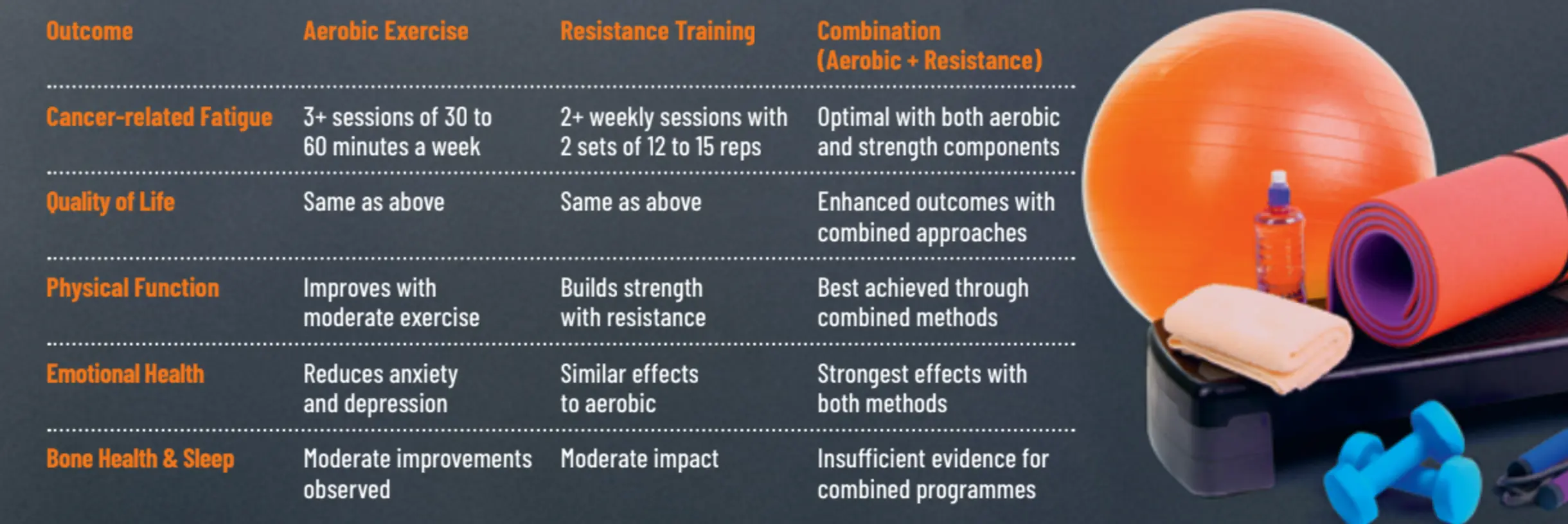News & Articles

Exercise & Cancer: How Staying Active Supports Recovery

Staying active during and after cancer treatment helps manage side effects, speed up recovery and boost overall well-being.
FACING CANCER CAN BE ONE OF LIFE'S TOUGHEST CHALLENGES, BUT INCORPORATING MOVEMENT INTO YOUR DAILY ROUTINE CAN BE A POWERFUL STEP TOWARDS RECLAIMING CONTROL. Whether it's a gentle walk, light stretching or resistance training, exercise helps rebuild strength, improves energy levels and enhances mental resilience. Beyond physical benefits, staying active provides a sense of purpose and normalcy, offering patients a way to feel empowered throughout their recovery journey.
What Can Exercise Achieve?
- Reduce treatment-related side effects such as fatigue, anxiety and depression.
- Improve physical functions, bone health and sleep quality.
- Support mental health by reducing stress and enhancing mood.
- Lower the risk of cancer recurrence and other chronic diseases.
Guidelines for Exercise in Cancer Patients
The American Cancer Society recommends:
- Aerobic Exercise: 150 to 300 minutes of moderate activity weekly, or 75 to 150 minutes of vigorous activity.
- Resistance Training: At least twice weekly to maintain strength and muscle mass.
- Combined Aerobic & Resistance: This approach provides significant benefits in managing cancer-related fatigue, enhancing quality of life, improving physical function and alleviating emotional challenges like anxiety and depression.
Key Evidence-Based Benefits of Exercise

Special Considerations
- Exercise intensity and type should be personalised based on cancer type, treatment stage and individual capacity.
- Light activities such as walking or stretching are beneficial for those new to exercise.
- Survivors should rebuild strength progressively, avoiding prolonged inactivity.
Getting Started with Exercise
DO:
- Start slow: Begin with 10 to 15 minutes of activity daily, gradually increasing intensity and duration.
- Find support: Join cancer-specific exercise programmes or support groups.
- Incorporate movement into your day: Walk instead of driving short distances, or take the stairs whenever possible.
- Mix it up: Combine activities like strength training, walking, cycling, swimming and stretching to improve overall health.
- Consult a professional: Always check with your healthcare provider before initiating an exercise routine during or after treatment.
AVOID:
- High-intensity workouts without guidance: This may lead to injury — consult your doctor first.
- Overexerting yourself: Listen to your body, and don't ignore symptoms like pain, dizziness, chest tightness or extreme fatigue.
- Skipping warm-ups and cool-downs: Ease into your routine with gentle stretches and end with relaxing exercises to prevent strain.
Even small steps matter. Incorporating movement into daily life — whether a short walk or light stretches — can profoundly support healing and overall well-being.
Practical Tip: A well-rounded exercise routine includes variety. Combine aerobic and strength training for maximum benefits, while focusing on consistency and safety.
| POSTED IN | Exercise, Life after Cancer |
| TAGS | cancer & exercise, cancer treatments, common side effects of cancer treatment |
| PUBLISHED | 01 March 2025 |
